-
Countries
-
Data and Analysis
-
Special Focus
-
Crisis Responses
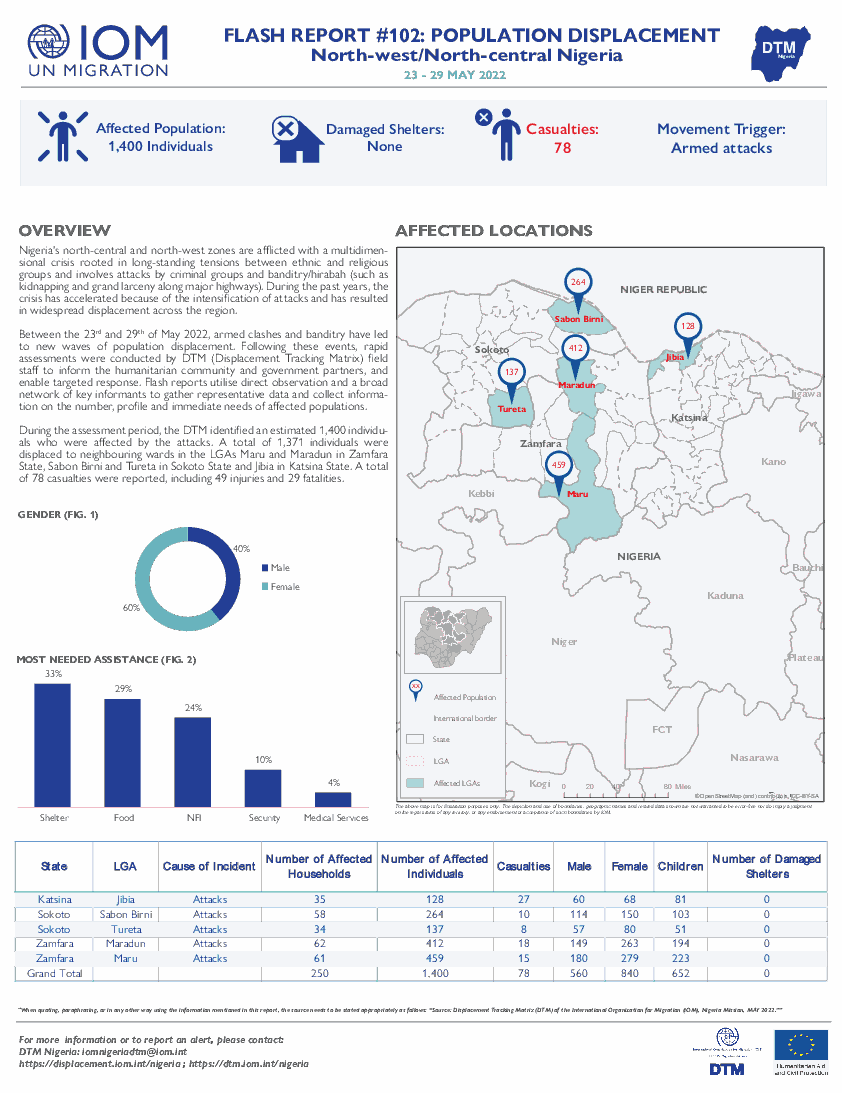
Contact
DTM Nigeria, AllUsersInDTMNigeria@iom.int
Language
English
Location
Nigeria
Period Covered
May 23 2022
May 29 2022
Activity
- Mobility Tracking
- Event Tracking
Nigeria's north-central and north-west zones are afflicted with a multidimensional crisis rooted in long-standing tensions between ethnic and religious groups and involves attacks by criminal groups and banditry/hirabah (such as kidnapping and grand larceny along major highways). During the past years, the crisis has accelerated because of the intensification of attacks and has resulted in widespread displacement across the region.
Between the 23rd and 29th of May 2022, armed clashes and banditry have led to new waves of population displacement. Following these events, rapid assessments were conducted by DTM (Displacement Tracking Matrix) field staff to inform the humanitarian community and government partners, and enable targeted response. Flash reports utilise direct observation and a broad network of key informants to gather representative data and collect information on the number, profile and immediate needs of affected populations.
During the assessment period, the DTM identified an estimated 1,400 individuals who were affected by the attacks. A total of 1,371 individuals were displaced to neighbouring wards in the LGAs Maru and Maradun in Zamfara State, Sabon Birni and Tureta in Sokoto State and Jibia in Katsina State. A total of 78 casualties were reported, including 49 injuries and 29 fatalities.

Contact
DTM Nigeria, AllUsersInDTMNigeria@iom.int
Language
English
Location
Nigeria
Period Covered
May 21 2022
May 27 2022
Activity
- Mobility Tracking
- Baseline Assessment
- Points of Entry (PoE)
During the COVID-19 pandemic, IOM's Displacement Tracking Matrix (DTM), in collaboration with the World Health Organization (WHO), monitors cross-border movements to and from Nigeria's Borno State in north-east Nigeria. Assessments are conducted at Points of Entry located along the border with Cameroon.
A range of data was collected during the assessments to better inform on travellers’ nationalities, sex, reasons for moving, mode of transportation and timeline of movement as shown in figures 2 to 5 below.
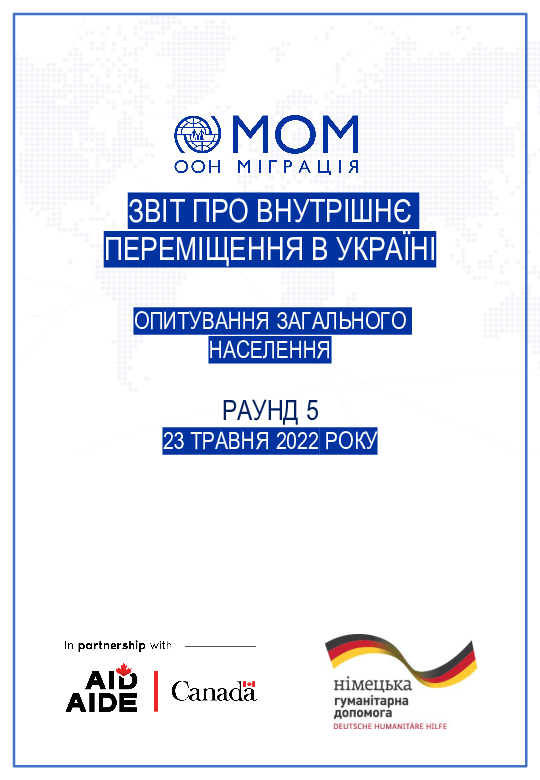
Contact
DTMUkraine@iom.int
Language
Ukrainian
Location
Ukraine
Period Covered
May 17 2022
May 23 2022
Activity
- Survey
Війна в Україні, яка розпочалася 24 лютого 2022 року, спричинила безпрецедентну гуманітарну кризу, що охопила всі області країни У період з 17 по 23 травня. Міжнародна організація з міграції ( провела п’ятий раунд репрезентативного експрес оцінювання загального населення України для збору інформації стосовно потоків внутрішнього переміщення та мобільності, а також для оцінювання місцевих потреб Це оцінювання загального населення слугує первинним
джерелом для виявлення сфер із високими гуманітарними потребами та визначення цільових заходів реагування для надання допомоги населенню, що постраждало від війни Географічне охоплення цього оцінювання покриває всю територію України, усі п’ять макрорегіонів ( схід, північ, центр, південь та місто Київ), за винятком Кримського півострова
Опитування загального населення було проведено шляхом набору випадкових телефонних номерів, завдяки чому було анонімно опитано 2 001 унікальних респондентів віком від 18 років із використанням методу автоматизованого телефонного опитування ( Оцінка спирається на дані про населення Фонду народонаселення ООН UNFPA) які гуманітарна спільнота розглядає як базове значення для чисельності населення в Україні Особи, які нині перебувають за
межами України, під опитування не потрапили Докладніше про метод і обмеження, у тому числі про визначення МОМ терміна «внутрішньо переміщені особи» для цілей цього оцінювання, див на с 11 Крім о питування загального населення, офіційні дані про присутність ВПО на рівні громад в Україні доступні в Матриці відстеження переміщень Базовому оцінюванні (раунд 3 15 травня 2022 року, HDX реєстрація обов’язкова)

Contact
DTM Europe, DTMMediterranean@iom.int
Language
English
Location
Republic of Moldova
Period Covered
Mar 09 2022
May 12 2022
Activity
- Survey
- Flow Monitoring
As the war in Ukraine has entered its fourth month, the civilian population is bearing the burden of ongoing hostilities. Since the onset of the war, Ukrainian refugees and Third Country Nationals (TCNs) have been fleeing from Ukraine to the Republic of Moldova; From 24 February to 12 May 2022, the Moldovan authorities have reported a cumulative total of 459,608 arrivals from Ukraine into the Republic of Moldova, of whom 420,772 (91.6%) are Ukrainian refugees and 38,836 (8.4%) TCNs. (Source: General Inspectorate for Border Police).
To inform an evidence based response, the International Organization for Migration (IOM), in partnership with UN Women, conducted a displacement survey with 12,814 Ukrainian refugees and TCNs in entry and exit border crossing points (BCP): Otaci, Palanca, Tudora, Giurgiulesti, Leuseni; and in transit centres: MoldExpo, the Ukrainian Consulate and the main bus station in Chisinau; and in reception centres and private accommodations between 09 Marchand 12May 2022.
Contact
DTM Burundi, DTMBurundi@iom.int
Location
Burundi
Activity
- Mobility Tracking
- Baseline Assessment
Period Covered
Apr 04 2022 -Apr 20 2022
A baseline assessment is a sub-component of mobility tracking. It aims to collect data on IDP, migrant or returnee population presence in a defined administrative area of the country.
Population Groups
Survey Methodology
Unit of Analysis Or Observation
Type of Survey or Assessment
Keywords
Geographical Scope
Administrative boundaries with available data
The current dataset covers the following administrative boundaries

Contact
DTM Mauritania, DTMMauritania@iom.int
Language
French
Location
Mauritania
Period Covered
Nov 01 2021
Jan 31 2022
Activity
- Survey
- Flow Monitoring Survey
- Flow Monitoring
- Mobility Tracking
Ce rapport présente les principaux résultats obtenus de novembre 2021 à janvier 2022, à travers les trois outils de suivi des mouvements de transhumance de l’OIM : le comptage, l’alerte et l’enquête détaillée. L’OIM, en partenariat avec les groupements pastoraux (GNAP et TASSAGHT) en Mauritanie et au Mali, a mis en œuvre ces outils au niveau de 12 localités de forte mobilité et de concentration de transhumants transfrontaliers, situées entre le Mali et la Mauritanie.
Durant la période de collecte de données, les transhumants observés au niveau de la frontière Mali, Mauritanie se déplaçaient de la Mauritanie vers le Mali. Cette tendance s’explique par le fait que cette période coïncidait avec la fin des récoltes au niveau du Mali. De ce fait, les transhumants qui étaient en Mauritanie se rendent au Mali à la recherche de pâturage à cause du déficit de pâturage noté en Mauritanie.
La grande majorité des transhumants interviewés dans les points de collecte de données, était de nationalité malienne (61%) et mauritanienne (36%). Les principales zones de départs sont entre autres les régions de Hodh El Gharbi (50%), Assaba (20%), Hodh Ech Chargi (12%) et autres (18%). Ils se dirigeaient essentiellement vers les régions de Kayes (63%) et Koulikoro (37%).
Les conditions et l’environnement de voyage font que la transhumance est réservée aux plus jeunes. L’âge moyen de la population transhumante enquêtée sur l’axe transfrontalier mauritano-malienne était de 36 ans. En effet, 84 pour cent des transhumants sont dans la classe d’âge 18-45 ans. L’évaluation du niveau d’éducation montre que la majorité des transhumants enquêtés (45%) ont fait l’école religieuse (école coranique), 36 pour cent ont affirmé ne pas fréquenter une école. La grande majorité des transhumants enquêtés (75%) est propriétaire des troupeaux qu’ils accompagnent dans leur mouvement de transhumance.
Durant la période de collecte, dans la zone frontalière du Mali et de la Mauritanie, au total 144 alertes ont été remontées par les sentinelles, dont 94 évènements et 50 mouvements. Dans le cadre du projet, un ensemble d’actions a été mis en place pour atténuer les conséquences des alertes, notamment par les comités villageois pour des besoins de médiation, de sensibilisation par information des relais de veille et d’alerte. Ces comités et relais, grâce aux informations collectées par le mécanisme d’alerte, ont pris part à la résolution de plusieurs conflits liés à occupation des champs de culture par les transhumants, des blessures d’animaux par des coups volontaires sur les animaux des éleveurs transhumants. Le rôle joué par les relais et comités villageois est important dans la mesure où les comités villageois dans leur mission de médiation ont pu circonscrire et éviter des conflits. Certains comités villageois ont contribué à la recherche et récupération de troupeaux par le biais des informations issues des relais de veille et d’alerte.
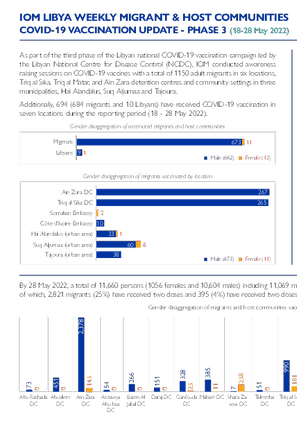
Contact
DTM Libya, DTMLibya@iom.int
Language
English
Location
Libya
Period Covered
May 18 2022
May 28 2022
Activity
- Other
As part of the third phase of the Libyan national COVID-19 vaccination campaign led by the Libyan National Centre for Disease Control (NCDC), IOM conducted awareness raising sessions on COVID-19 vaccines with a total of 1150 adult migrants in six locations, Triq al Sika, Triq al Matar, and Ain Zara detention centres and community settings in three municipalities, Hai Alandalus, Suq Aljumaa and Tajoura. Additionally, 694 (684 migrants and 10 Libyans) have received COVID-19 vaccination in seven locations during the reporting period (18 - 28 May 2022).
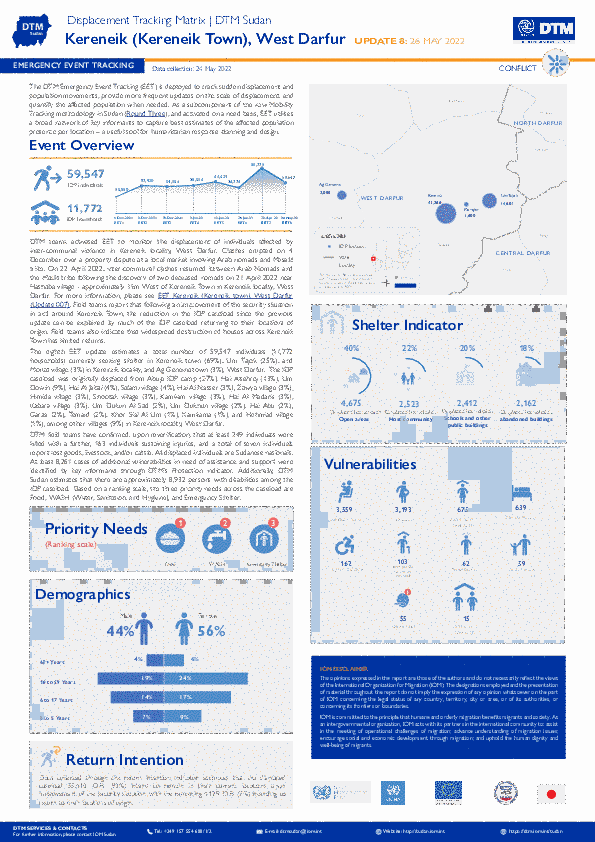
Contact
DTM Sudan; dtmsudan@iom.int
Language
English
Location
Sudan
Snapshot Date
May 24 2022
Activity
- Mobility Tracking
- Event Tracking
The DTM Emergency Event Tracking (EET) is deployed to track sudden displacement and population movements, provide more frequent updates on the scale of displacement, and quantify the affected population when needed. As a subcomponent of the new Mobility Tracking methodology in Sudan (Round Three), and activated on a need basis, EET utilises a broad network of key informants to capture best estimates of the affected population presence per location – a useful tool for humanitarian response planning and design.
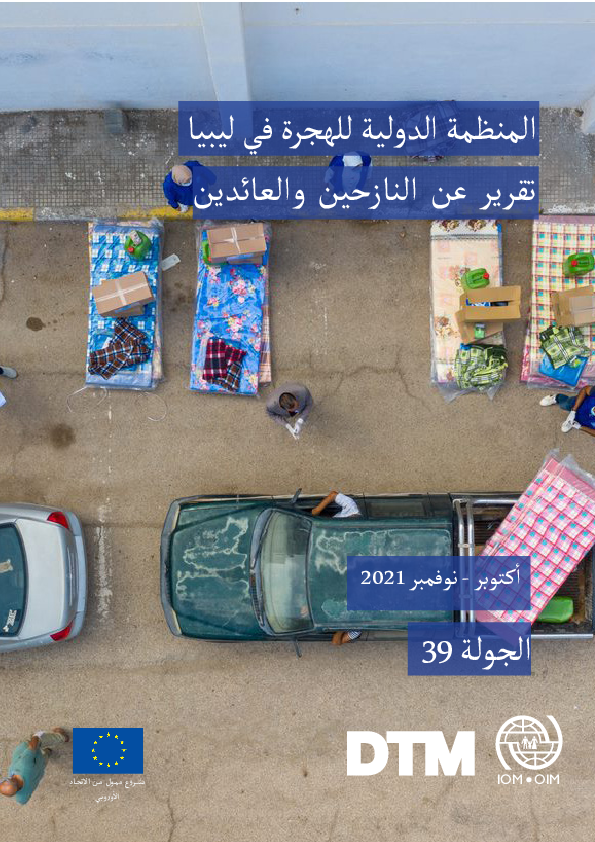
Contact
DTM Libya, DTMLibya@iom.int
Language
Arabic
Location
Libya
Period Covered
Oct 01 2021
Nov 30 2021
Activity
- Mobility Tracking
- Baseline Assessment
يعرض هذا التقرير البيانات المجمّعة فيما بين شهري أكتوبر ونوفمبر من سنة 2021 حول النازحين داخليا والعائدين. وتمثّل هذه البيانات والمستخلصات الجولة 39 من تتبع التنقل في ليبيا التي أجرتها مصفوفة تتبع النزوح. ولم يتم الإبلاغ عن أيّة حركات نزوح كبرى منذ شهر يونيو من سنة 2020 وطوال السنة الجارية، فيما تواصل نسق عودة الأسر النازحة مسبقا إلى مناطقها الأصلية. وتماشيا مع التوجه الذي امتد على مدار السنة، استمرّ انخفاض عدد النازحين في ليبيا في هذه الجولة، ورافق ذلك ارتفاع في عدد العائدين. وقد ارتفع عدد العائدين في الجولة 39 ليبلغ 661.892 عائداً في مقارنة بالجولة 38 التي تم فيها تسجيل 648.317 فرداً. ويشير ذلك إلى زيادة طفيفة في نسبة العائدين (بنسبة 2 في المائة) بعد فترة من الاستقرار دامت على مدار الأشهر الستة الأخيرة. وفي أعقاب موجة العودة، تواصل عدد النازحين في الانخفاض في هذه الجولة، ممّا يقدّر بـ 199.949 نازحاً في شهر سبتمبر من سنة 2021 إلى 179.046 نازحاً بنهاية شهر نوفمبر. ويمثّل ذلك انخفاض بما يقارب 21.000 فرداً (بنسبة 10 في المائة) على مدار فترة الدراسة وبالتزامن مع استمرار موجة عودة الأسر النازحة إلى مناطق أصلها.

Contact
DTM Burundi, DTMBurundi@iom.int
Language
French
Location
Burundi
Period Covered
Jan 01 2022
Mar 31 2022
Activity
- Flow Monitoring Survey
- Flow Monitoring
Ce rapport présente une analyse des enquêtes de suivi des flux (Flow Monitoring Survey, FMS) réalisées entre janvier 2022 et mars 2022. Au cours de cette période, 3 115 entretiens ont été menés auprès des voyageurs ayant traversé huit (8) points de suivi des flux (Flow Monitoring Points, FMPs): Gasenyi-Nemba frontalier avec le Rwanda au Nord du Burundi, Gatumba situé à la frontière avec la République Démocratique du Congo à l’Ouest du Burundi et six points de suivi de flux dont Kabogo, Mbundi, Kwa Rutuku, Mukambati, Kabuyenge et Kwa Buhinja installés à l’est du Burundi à la frontière avec la République Unie de Tanzanie. Ces enquêtes font partie des activités de suivi des flux mises en oeuvre par l‘OIM par le biais de la Matrice de Suivi des Déplacements (Displacement Tracking Matrix, DTM).
